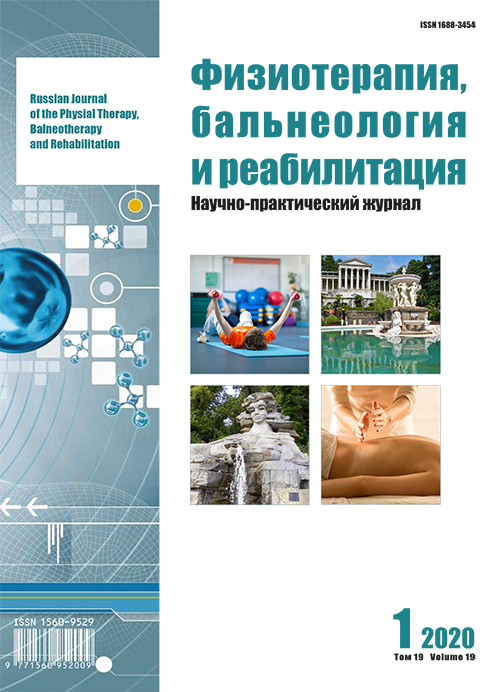The effectiveness of the combined use of fractional microneedle rf-therapy and pharmacophoresis of hyaluronic acid in the treatment of patients with atrophic scars
- 作者: Talybova A.M.1, Stenko A.G.2, Kruglova L.S.2
-
隶属关系:
- Central State Medical Academy of the Administrative Department of the President of the Russian Federation
- Head of the Cosmetology Department of the Institute of Plastic Surgery and Cosmetology JSC
- 期: 卷 19, 编号 1 (2020)
- 页面: 32-39
- 栏目: Original studies
- URL: https://journals.rcsi.science/1681-3456/article/view/41833
- DOI: https://doi.org/10.17816/1681-3456-2020-19-1-5
- ID: 41833
如何引用文章
详细
Background. The formation of scar tissue is a fairly physiological process, in most cases aimed at closing the skin defect in order to preserve the body’s homeostasis. Correction methods for atrophic scars include laser technology, radiofrequency therapy, injection methods and topical therapy.
Arm: the formation of scar tissue is a fairly physiological process, in most cases aimed at closing the skin defect in order to preserve the body’s homeostasis. Correction methods for atrophic scars include laser technology, radiofrequency therapy, injection methods and topical therapy.
Methods. There were 56 patients with atrophic scar. Depending on the therapeutic complex for the correction of аtrophic scar, 3 groups were formed: group 1 ― the combined use of RF-therapy for the pharmacophoresis of hyaluronic acid, group 2 ― radio frequency microneedle therapy, group 3 ― the pharmacophoresis of hyaluronic acid. In the work, the Dermatological Symptom Scale Index (DSSI), which was assessed before and after treatment, was adapted to evaluate clinical symptoms.
Results. In accordance with the total value of the DSSI, a more significant dynamics was observed in group 1, regardless of the type of AR (subgroups 1A and 1B). DSSI in the 1A subgroup decreased by 80.8% (p<0.01), in the 1B group by 82.4% (p<0.01). DSSI in the 2A subgroup decreased by 32.3% (p<0.01), in the 2B group by 61.4% (p<0.01). DSSI in the 3A subgroup decreased by 62.3% (p<0.01), in the 3B group by 33.7% (p<0.01). In group 1, where the combined treatment was carried out, a more pronounced efficacy was noted than when applying the components of the technique, which did not depend on the type of cicatricial deformity. In group 2, after the application of RF-therapy, the effectiveness was expressed to a much lesser extent, and the most significant results were obtained in patients with post-traumatic atrophic scars. In group 3, after a course of pharmacophoresis of a hyaluronic acid preparation, positive dynamics was observed to a greater extent with hormone-dependent scars.
Conclusions. The results of the study showed that the most effective method is the combined use of RF-therapy and the pharmacology of hyaluronic acid, at the same time with post-inflammatory (post-traumatic) atrophic scars, monotherapy with the use of radiofrequency microneedles is possible, with hormone-dependent atrophic scars, monotherapy of pharmacophoresis of hyaluronic acid is possible.
作者简介
A. Talybova
Central State Medical Academy of the Administrative Department of the President of the Russian Federation
编辑信件的主要联系方式.
Email: journal@eco-vector.com
ORCID iD: 0000-0003-2081-7416
MD, PhD
俄罗斯联邦, MoscowA. Stenko
Head of the Cosmetology Department of the Institute of Plastic Surgery and Cosmetology JSC
Email: journal@eco-vector.com
ORCID iD: 0000-0002-6686-4253
MD, PhD
俄罗斯联邦, MoscowL. Kruglova
Head of the Cosmetology Department of the Institute of Plastic Surgery and Cosmetology JSC
Email: journal@eco-vector.com
ORCID iD: 0000-0002-5044-5265
MD, PhD
俄罗斯联邦, Moscow参考
- Talybova AM, Kruglova LS, Stenko AG, et al. Classification of scar lesions and criteria of treatment efficiency. Med Tr Prom Ekol. 2017;(8):22–26. (In Russ).
- Stenko AG, Kotenko KV, Talybova AP, et al. Clinical evaluation of cicatricial skin lesions. Textbook. Moscow: FSBI TsGMA; 2016. 38 р. (In Russ).
- Wang HB, Fang Y, Yu WR. [Advancement in the research of fractional carbon dioxide laser in treating burn scars. (In Chinese)]. Zhonghua Shao Shang Za Zhi. 2012; 28(6):465–467.
- Fisenko GI. Korrektsiia rubtsovykh izmenenii kozhi litsa metodom rannei povtornoi dermabrazii. [dissertation abstract] Moscow; 2005. 24 р. (In Russ).
- Zhang M, Qureshi AA, Hunter DJ, Han J. A genome-wide association study of severe teenage acne in European Americans. Hum Genet. 2014;133(3):259–264. doi: 10.1007/s00439-013-1374-4.
- Sachdeva S. Lactic acid peeling in superficial acne scarring in Indian skin. J Cosmet Dermatol. 2010;9(3): 246–248. doi: 10.1111/j.1473-2165.2010.00513.x.
- Majid I. Microneedling therapy in atrophic facial scars: An objective assessment. J Cutan Aesthet Surg. 2009;2(1):26–30. doi: 10.4103/0974-2077.53096.
- Talybova AP, Kruglova LS, Stenko AG. The additive therapy of atrophic scars. Physiotherapist. 2017;(1):64–69. (In Russ).
- Talybova AP, Stenko AG, Korchazhkina NB. Innovative physiotherapeutic technologies in the treatment of combined cicatricial changes in the skin. Physiotherapist. 2017;(1):47–55. (In Russ).
- Kruglova L. S., Kotenko K.V., Korchazhkina N.B., Turbovskaya S.N. Fizioterapiya in dermatology. Monograph, Prod. Moscow: Geotar-media, 2016. 303 p.
补充文件






